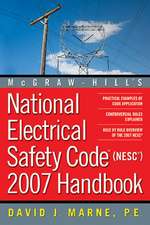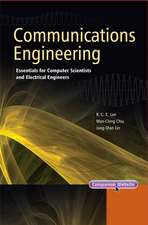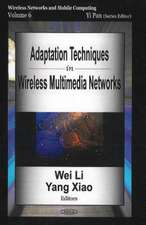Analytical Modeling of Wireless Communication Systems
Autor CF Chiasserinien Limba Engleză Paperback – 9 iun 2016
Preț: 969.26 lei
Preț vechi: 1065.12 lei
-9% Nou
Puncte Express: 1454
Preț estimativ în valută:
185.53€ • 201.59$ • 155.94£
185.53€ • 201.59$ • 155.94£
Carte tipărită la comandă
Livrare economică 22 aprilie-06 mai
Preluare comenzi: 021 569.72.76
Specificații
ISBN-13: 9781848219441
ISBN-10: 184821944X
Pagini: 150
Dimensiuni: 166 x 232 x 9 mm
Greutate: 0.22 kg
Editura: ISTE Ltd.
Locul publicării:Hoboken, United States
ISBN-10: 184821944X
Pagini: 150
Dimensiuni: 166 x 232 x 9 mm
Greutate: 0.22 kg
Editura: ISTE Ltd.
Locul publicării:Hoboken, United States
Public țintă
Scientists, researchers and engineers interested in this subject areaCuprins
Preface ix
Introduction xi
List of Acronyms xv
Part 1. Sensor Networks 1
Chapter 1. Fluid Models and Energy Issues 3
1.1. The fluid–based approach 4
1.1.1. Sensor density and traffic generation 5
1.1.2. Data routing 5
1.1.3. Local and relay traffic rates 6
1.1.4. Channel contention and data transmission 6
1.1.5. Mean packet delivery delay 7
1.1.6. Sensor active/sleep behavior 7
1.2. Network scenario 7
1.3. The sensor network model 11
1.3.1. A minimum energy routing strategy: computing u(r:r) 11
1.3.2. Channel contention and data transmission: computing s(r) and PR(r) 17
1.3.3. Mean packet delivery delay: computing q(r) 22
1.4. Results 24
1.4.1. Model validation 25
1.4.2. Model exploitation 28
1.4.3. Model solution complexity and accuracy 35
Chapter 2. Hybrid Automata for Transient Delay Analysis 37
2.1. Event detection in WSNs 37
2.1.1. The 802.15.4 MAC protocol 39
2.2. Model for single–hop network topologies 40
2.2.1. Single message transfer 40
2.2.2. Multiple message transfers 43
2.3. Solution technique 44
2.3.1. Time discretization 44
2.3.2. Transient solution 46
2.3.3. Performance metrics computation 49
2.4. Model for multi–hop network topologies 50
2.5. Model validation and exploitation results 52
2.6. Discussion 57
Part 2. Vehicular Networks 59
Chapter 3. Safety Message Broadcasting 61
3.1. System description 62
3.2. Dissemination of safety messages 63
3.2.1. The spatial differentiation approach 63
3.2.2. The safety application 64
3.3. Assumptions and notations 65
3.4. Model outline 66
3.5. Computation of the block probability 67
3.6. Computation of the probability of first reception 69
3.6.1. A Gaussian approximation to the transient system behavior 73
3.7. Performance evaluation 77
3.7.1. The impact of power capture 77
3.7.2. The case of occupation probability = 1 79
3.7.3. The case of homogeneous occupation probability < 1 80
3.7.4. The case of inhomogeneous occupation probability 83
3.7.5. The impact of the forwarding policy 85
Chapter 4. Modeling Information Sharing 89
4.1. System scenario 89
4.2. Modeling information exchange in IVN 90
4.2.1. Model description 91
4.3. Computation of the probability of successful information retrieval 93
4.4. Model validation and exploitation 98
Part 3. Cellular Networks 103
Chapter 5. Multi–RAT Algorithms 105
5.1. RAT network 106
5.1.1. Scenario 107
5.1.2. RAT selection strategy 108
5.2. Network model 109
5.2.1. Functional rates 110
5.3. Model solution 115
5.3.1. Analytical approach 115
5.3.2. Computation of performance metrics 117
5.4. Performance evaluation 118
5.4.1. Setting and results 119
Bibliography 123
Index 127
Introduction xi
List of Acronyms xv
Part 1. Sensor Networks 1
Chapter 1. Fluid Models and Energy Issues 3
1.1. The fluid–based approach 4
1.1.1. Sensor density and traffic generation 5
1.1.2. Data routing 5
1.1.3. Local and relay traffic rates 6
1.1.4. Channel contention and data transmission 6
1.1.5. Mean packet delivery delay 7
1.1.6. Sensor active/sleep behavior 7
1.2. Network scenario 7
1.3. The sensor network model 11
1.3.1. A minimum energy routing strategy: computing u(r:r) 11
1.3.2. Channel contention and data transmission: computing s(r) and PR(r) 17
1.3.3. Mean packet delivery delay: computing q(r) 22
1.4. Results 24
1.4.1. Model validation 25
1.4.2. Model exploitation 28
1.4.3. Model solution complexity and accuracy 35
Chapter 2. Hybrid Automata for Transient Delay Analysis 37
2.1. Event detection in WSNs 37
2.1.1. The 802.15.4 MAC protocol 39
2.2. Model for single–hop network topologies 40
2.2.1. Single message transfer 40
2.2.2. Multiple message transfers 43
2.3. Solution technique 44
2.3.1. Time discretization 44
2.3.2. Transient solution 46
2.3.3. Performance metrics computation 49
2.4. Model for multi–hop network topologies 50
2.5. Model validation and exploitation results 52
2.6. Discussion 57
Part 2. Vehicular Networks 59
Chapter 3. Safety Message Broadcasting 61
3.1. System description 62
3.2. Dissemination of safety messages 63
3.2.1. The spatial differentiation approach 63
3.2.2. The safety application 64
3.3. Assumptions and notations 65
3.4. Model outline 66
3.5. Computation of the block probability 67
3.6. Computation of the probability of first reception 69
3.6.1. A Gaussian approximation to the transient system behavior 73
3.7. Performance evaluation 77
3.7.1. The impact of power capture 77
3.7.2. The case of occupation probability = 1 79
3.7.3. The case of homogeneous occupation probability < 1 80
3.7.4. The case of inhomogeneous occupation probability 83
3.7.5. The impact of the forwarding policy 85
Chapter 4. Modeling Information Sharing 89
4.1. System scenario 89
4.2. Modeling information exchange in IVN 90
4.2.1. Model description 91
4.3. Computation of the probability of successful information retrieval 93
4.4. Model validation and exploitation 98
Part 3. Cellular Networks 103
Chapter 5. Multi–RAT Algorithms 105
5.1. RAT network 106
5.1.1. Scenario 107
5.1.2. RAT selection strategy 108
5.2. Network model 109
5.2.1. Functional rates 110
5.3. Model solution 115
5.3.1. Analytical approach 115
5.3.2. Computation of performance metrics 117
5.4. Performance evaluation 118
5.4.1. Setting and results 119
Bibliography 123
Index 127










